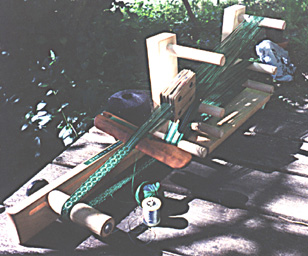Tablet weaving or card weaving as it is alternately known, is a beautiful and ancient textile art dating to the Middle Ages and earlier. Weaving technique for the above trim, in shades of green, silver and black, is basic to cardweaving -- four quarter-turns toward the weaver, followed by four quarter-turns away with the patterning determined by the warping of the cards. It is just one of many beautiful patterns that can be created with this technique. The warp was strung on an inkle loom for greater ease in portability.
Cparkhill1730 16:53, 27 October 2007 (UTC)
Creating this pattern
Each card has four holes, labeled A, B, C and D. For ease, you may wish to number your cards to correspond with the number of cards called for in the pattern, which is represented below. When threaded, and as you face them and prepare to weave, the printed sides of each card should be to your left, and they should be in the same left-to-right order as the diagram.
Following the diagram from left to right, the first nine cards should be threaded from left to right (printed to un-printed); the remaining nine from right to left (un-printed to printed side). "G" is green, "B" is black and "S" is silver, but you may substitute other colors to your liking.
Once all the cards are threaded, you may begin weaving. As the cards are turned, the pattern will form based upon the color of yarn threaded through each hole and the direction of the yarn. Your frame of reference for when to change directions is when the cards return to their "home position" -- that is, when the D and A holes are on top.
G B G G G G S S G G S S G G G G B G -- A
G B G G G S S G G G G S S G G G B G -- B
G B G G S S G G B B G G S S G G B G -- C
G B G S S G G G G G G G G S S G B G -- D
1 2 3 4 5 6 7 8 9 0 1 2 3 4 5 6 7 8
> > > > > > > > > < < < < < < < < <



